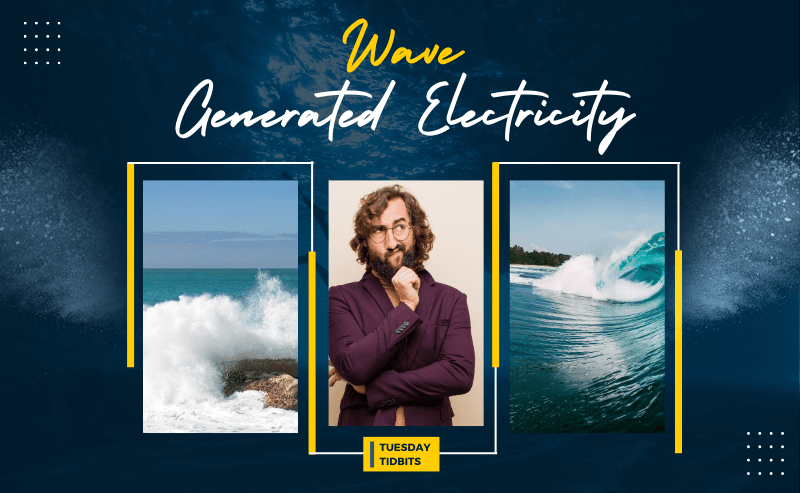We use electricity every day, but most people don’t stop to think about how it’s made and how its production might change. But researchers have been thinking about it for decades. In a quest for new ways of quelling our current global energy crisis, researchers have determined a new, viable source of electricity: ocean waves. Wave energy has the potential to end the energy crisis and improve the environment at the same time. In fact, according to the U.S. Energy Information Administration, the waves around the United States’ coasts could provide 66% of the country’s electricity (2.64 trillion kilowatt hours) every year.
Waves have the highest energy density of renewable energy sources. According to researchers at the University of Plymouth, this means that waves have the greatest potential to be an important contributor to the world’s “energy mix resilience.” The challenge is that wave energy is far behind in its development as compared to other renewable energies like wind, solar, biomass and geothermal.
What is Wave Power?
Wave power is the capture of wind-wave energy to generate electricity. It’s accomplished via a wave energy converter (WEC) that exploits wave power. Waves are generated by wind passing over the sea’s surface. As long as the waves propagate slower than the wind speed just above, energy is transferred from the wind to the waves. Air pressure differences between the windward and leeward sides of a wave crest and surface friction from the wind cause shear stress (two materials rubbing against or sliding over each other) and wave growth.
Wave power is, however, distinct from tidal power, which captures the energy of the current caused by the gravitational pull of the Sun and Moon. Other forces can create currents, including breaking waves, wind, the Coriolis effect (a mass moving in a rotating system experiences a force acting perpendicular to the direction of motion and to the axis of rotation), cabbeling (the mixing of two separate water parcels to form a third, which sinks below both parents), and differences in temperature and salinity (the dissolved salt content of a body of water).
While wave power holds promise, it’s proven difficult to build machines that can harness that energy, due to the violent movement and corrosive nature of the ocean combined with the complex motion of waves themselves. That’s because, unlike windmills (which are linear) ocean winds and currents are oscillating. As a result, they’re not easy to “catch.” But some new technologies just might unlock the answer.
The Department of Energy Funds U.S. Wave Energy Projects
According to a CNBC report, PacWave, a U.S. Department of Energy (DOE)-funded wave energy test site off the Oregon Coast, is set to become the U.S.’s first full-scale, grid-connected test facility for wave power technology when it comes online in the next few years. At the beginning of 2022, the DOE announced $25 million in funding for eight wave energy projects to test their technology at PacWave.
Of the eight projects, Bay Area-based CalWave received the largest amount — $7.5 million. A small-scale version of their xWave™ device recently returned following a successful 10-month deployment off the coast of San Diego. And the x800™, PacWave’s megawatt-class system, produces enough power to provide electricity to about 3,000 households.
CalWave’s device operates completely below the surface of the water. As waves rise and fall, surge forward and backward and move in a circular motion, the device moves as well. Dampers inside the device slow down the motion and convert it into torque, which drives a generator to produce electricity.
A different approach is being piloted by Seattle-based Oscilla Power, which was awarded $1.8 million from the DOE, and is getting ready to deploy its wave energy converter off the coast of Hawaii, at the U.S. Navy Wave Energy Test site.
Oscilla Power’s device is composed of two parts, one of which floats on the surface and moves with the waves in all directions — up and down, side to side and rotationally. This float is connected to a large, ring-shaped structure that hangs below the surface and is designed to stay relatively steady. The difference in motion between the float and the ring generates force on the connecting lines, which then rotates a gearbox to drive a generator.
The DOE awarded more than $4 million to Charlottesville, Virginia-based C-Power to test its grid-scale wave energy converter at PacWave. But first, the company wants to commercialize its smaller-scale system, the SeaRAY, which is designed for lower-power applications. The SeaRAY consists of two floats and a central body, the nacelle, which contains the drivetrain. As waves pass by, the floats bob up and down, rotating about the nacelle and turning their own respective gearboxes that power the electric generators.
Eventually, C-Power plans to scale up its SeaRAY so that it will be capable of satellite communications and deep-water deployments. Their larger system — the StingRAY — will provide terrestrial electricity generation.
Global Research into Wave-Generated Electricity
Researchers in China have their own approach to wave power, having built multiple small nanogenerators that float on the surface of the ocean. Each of the nanogenerators is linked to the others via a flexible connector. Static electricity generated by all of the nanogenerators is then pooled to be tapped and used as a power source. The nanogenerators have spring-like coils inside of them with parts that rub up against one another as the device is moved by waves. The touching parts generate static electricity, just like socks in a dryer.
A test run of the Chinese team’s idea showed it capable of generating 347 watts of power per cubic meter, which they note is approximately 30 times better than other designs geared to reap electricity from waves.
In the UK, there are active wave energy projects in Scotland, England and Wales. Wave Energy Scotland, a national technology development body backed by the Scottish government, has invested more than $52 million (£40 million) in almost 100 projects since it was set up in 2014.
Meanwhile, in Sweden, CorPower Ocean has built the world’s largest wave energy test rig at its base in Stockholm. And Eco Wave Power, with offices in Stockholm and TelAviv, is taking another approach completely, with simpler wave power devices that can be installed on breakwaters, piers and jetties. Instead of residing in floaters, like in competing technologies, all the expensive conversion machinery in the Eco Wave Power’s device sits on land, just like a regular power station. As a result, installation, operation and maintenance costs are low. The floaters sit atop the water, and move up and down with the motion of the waves. This drives a hydraulic piston that compresses fluid that’s then stored in an accumulator. When the fluid is released, it turns a hydraulic motor, which powers an electric generator.
Eco Wave Power has produced power for the grid in Gibraltar, and it is finalizing another grid-connected station in Israel, both of which can power about 100 homes at peak efficiency. And Eco Wave Power has signed an agreement to install its tech at the Port of Los Angeles.
Wave Energy Potential vs. Roadblocks
One of the most exciting aspects of research into wave power is its potential to generate electricity in remote regions, which currently rely on expensive and polluting diesel imports to meet their energy needs when other renewables aren’t available. Before wave energy is adopted at-scale, many believe that wave energy will first replace diesel generators in off-the-grid communities.
But there are still many unknowns when it comes to wave energy tech, including the question of whether it can become cost-effective enough to compete with fossil fuels (about $0.06 per kilowatt-hour). Currently, the projected costs for wave energy technologies are estimated to be $0.60 to $1.00 per kilowatt-hour.
And then, of course, there is concern over the potential impact of these devices on marine ecosystems. While DOE is providing funding for assessing the interaction of species with deployed systems, it will take time for them to get the full picture.









I can see it now….the folks who complain about wind turbines miles off shore will have a field day with wave generators.